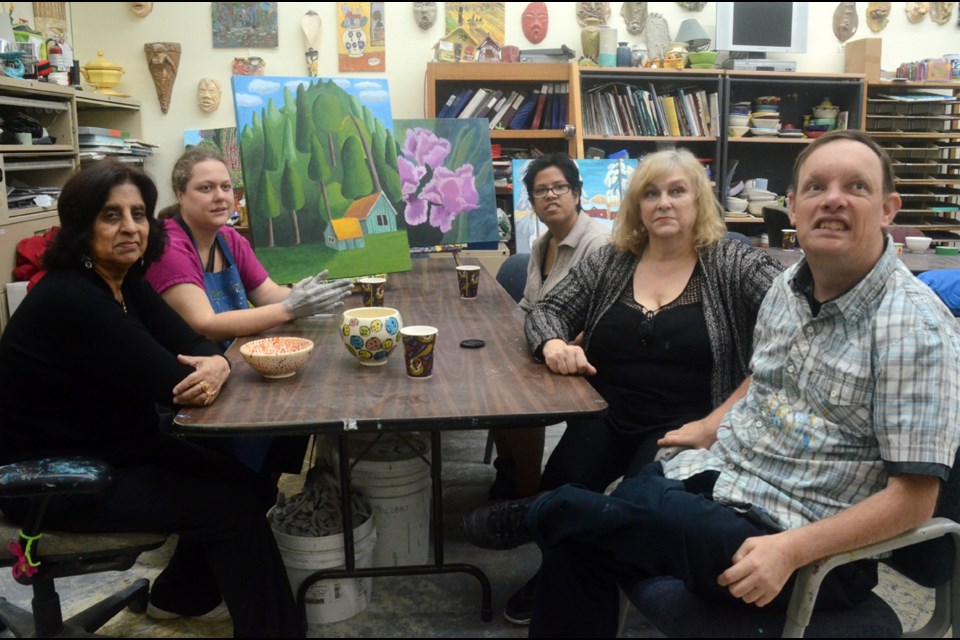Fifteen years ago, Deidre Blackmore had an idea.
In some form or another, the New Westminster resident wanted to merge the “two halves” in her life into one. That is, her love of pottery and her love of working with people with disabilities. Throughout her career, Blackmore had worked as a professional artist and in group homes as a care aid.
“I knew what being a creative person had done for me in my life,” she told the Record. “It goes back to as a young person, it’s like how do I fit into this world that I just kind of appeared in?”
June 14, 2000 is the day that idea turned into a reality – PotteryWorks Studio on Royal Oak Avenue in Burnaby opened its doors. The Community Living Society had hired her to develop a pottery program, one which would be geared towards artists who’ve had to overcome challenges. It would be a place where they could come to perfect their craft and sell their pieces at shows and galleries around the Lower Mainland.
“I always felt that starting this program could give that identity to our artists. Other than that, their identity is as someone with a disability,” said Blackmore, who teaches both pottery and painting.
Initially, the studio started with six artists. Blackmore remembered having just $50, money she used to buy enough clay to make some Christmas ornaments.
“We made $600 from that,” she said, adding about half of the sale price, if not more, goes back to the artist, with the rest covering supply costs.
Today, PotteryWorks Studio has grown significantly. It has attracted nearly 60 artists, has expanded to include photography, and has made a name for itself at multiple art shows over the years, including this week’s INCLUSION Art Show & Sale in Vancouver.
In 2012, the studio opened its first retail space in the River Market at Westminster Quay. The space, Blackmore explained, is not only used to sell art, but to give demonstrations to passersby of how pottery art is done.
But one of things that surprised her when she first started the program was that students didn’t put a whole lot of weight on making money off their work.
“You have situations where some of our artists have brothers and sisters and they grew up in a family and watched them go to university, get a car and get married, all the things we all look forward to. That’s not happening for them,” said Blackmore, who’s often referred to as “Dee” around the building. “I would say, ‘We’ll put that in a show and make you lots of money,’ and they’d say, ‘I want to give it to my family.’ … It’s self-esteem; they’re good at something. They’ve found something they’re good at and they start to self-identify as artists in the larger community.”
Dan Tell has been with PotteryWorks Studio for about 12 years, working both as a potter and as a painter. Having come in with the least natural artistic ability, the teacher tells the Record he’s had the most determination and drive out of all of his peers.
“He would come all the time, put his head down and work. You could see he’d get frustrated, but he’d keep trying and keep trying, and so, he’s developed incredible skills over a long period of time,” Blackmore said of his flower and fruit bowls.
Sherilyn Seitz, meanwhile, has a natural eye when it comes to being behind a camera. Some of her photos – close-ups of everyday items, like glass and bark – will be on display at the INCLUSION event.
“My mom and dad really are proud of me and my brother is too,” she said with a smile.
Even some staff have discovered their own talents.
“There’s a bit of a fallacy out in the world that you need to be born with this enormous talent and then you can do this. It’s 90 per cent practice and hard work,” Blackmore said.
PotteryWorks Studio has been picking up momentum recently, with venues now contacting Blackmore, instead of the other way around. Their biggest event to-date is scheduled for next summer at UBC.
Besides giving her students an identity, the goal of the program is to break down stereotypes, according to the professional potter.
“By doing this, we’re trying to show our larger community the value of our artists, what they’re capable of and who they are, to sort of take away the stigma because people tend to see the disability first when actually, underneath whatever the disability is, there’s a very large person that isn’t always evident.”
There was a moment of pause, however, when asked how being in this role has changed her personally.
“Sometimes it’s like riding a galloping horse,” she laughed. “Rewarding doesn’t even cover it. These are long-term relationships I’ve made with the artists and with staff. It’s been a very profound thing in my life. I had the idea to do it and I knew it could work and it’s become more than I ever dreamed."



